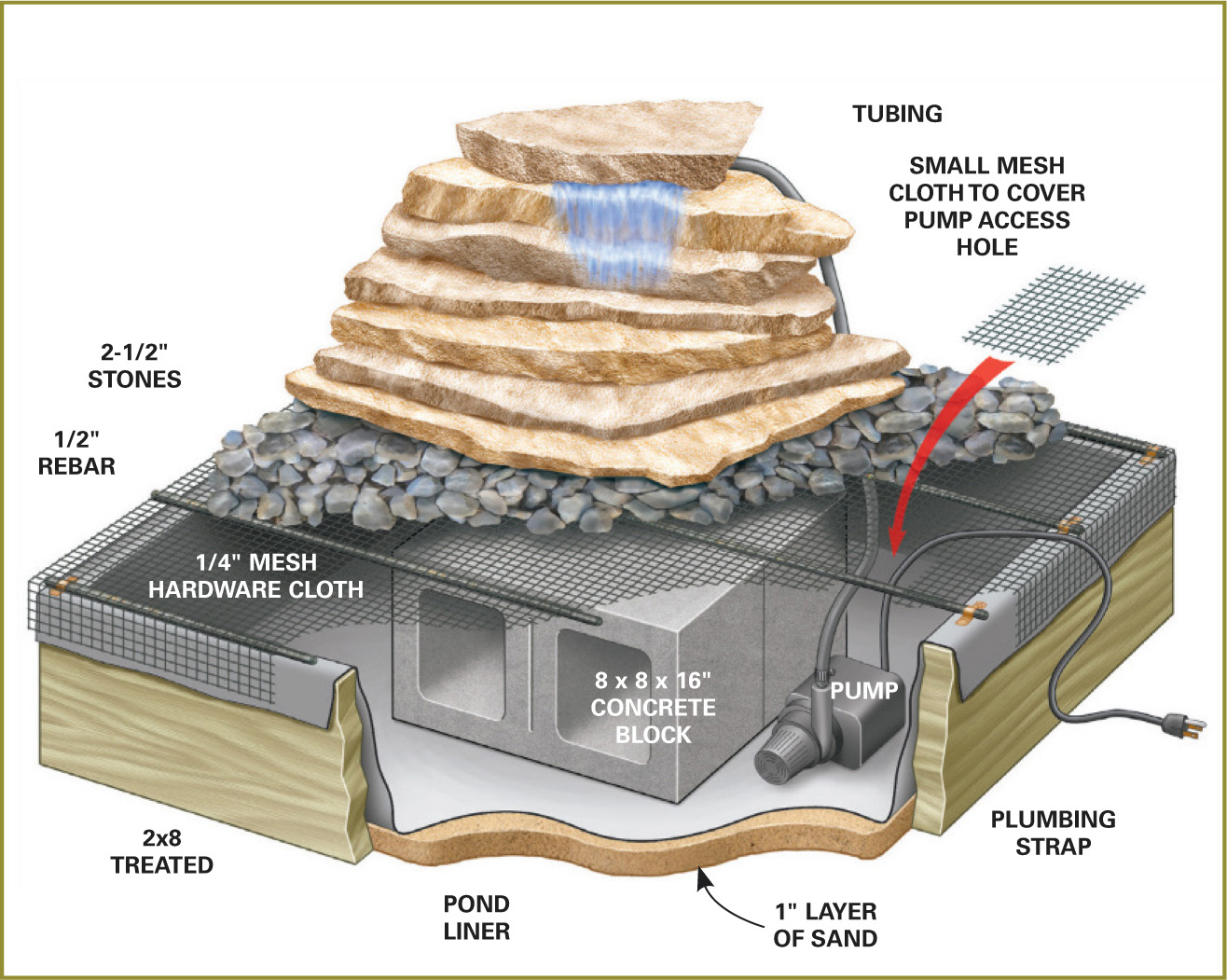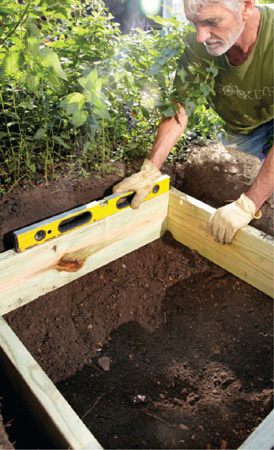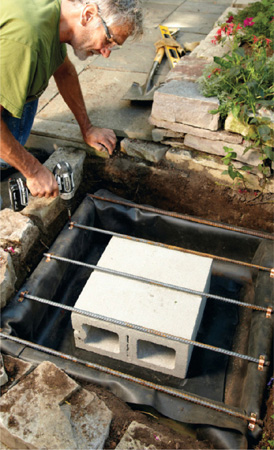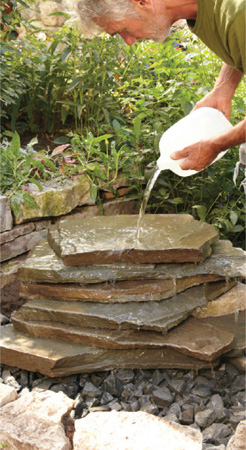
WHAT IT TAKES
Time: 1 day
Skill level: Beginner

WHAT IT TAKES
Time: 1 day
Skill level: Beginner
There are a thousand ways to build a backyard fountain. But if you’re looking for simplicity, you can’t beat this approach. You basically dig a hole in the ground, line it with rubber membrane and cover it with a stack of rocks. The waterfall looks beautiful, but the best part is the sound. If you close your eyes, it’s easy to imagine yourself sitting next to a gurgling creek in the middle of the woods.
Once the materials were in hand, the project took less than a day. We were a little surprised at how much digging there was, considering the size of the reservoir. But this was the only tough part. Stacking the stone was fun. We had to rearrange the stones a few times, but in the end the water flowed nicely over the edges and created just the effect we wanted.
Gather your supplies ahead of time
Check local landscape suppliers and home centers to find the stone, pump and pond liner. You can also order a pump online. A home center or lumberyard will have the treated lumber, rebar, hardware cloth and miscellaneous hardware you’ll need. We spent about $150 for 700 lbs. of bluestone and $125 on the remaining items.
Pick out your stones
You’ll need a minivan or truck to haul this much stone, or you’ll have to make several trips with your car. At the stone yard, start by finding a large, flat stone for the base. Ours was about 24 in. across. Then stack stones on top in an arrangement you like. When you think you’ve got enough, add a few more for good measure. Don’t forget to pick up three or four 5-gallon buckets full of crushed stone for the base. For this we used gray stones that ranged from 2 to 2-1/2 inches in diameter.
Dig the hole and build the frame
Using 2x8s like we did, you’ll need a hole that’s about 8 in. deep. In our garden, stone walls limited the size of our reservoir to about 30 in. across, but if you have room, make it bigger. The bigger the reservoir, the less often you’ll have to fill it with water.
The first step is to cut the 2x8s to length and nail or screw them together. Use stainless steel or corrosion-resistant screws. Set the frame in the hole and level it (Photo 1). Then spread a 1-in. layer of sand over the bottom. Cut a square of pond liner about 2 ft. wider and longer than the inside dimensions of the frame and lay it in place. Fold the pond liner to fit the inside corners and let the extra drape down the outside of the frame. From the leftover material, cut a 20-in. square of pond liner and lay it in the center as padding for the two concrete blocks. Then set the two concrete blocks into place and wiggle them into the sand until the tops are level with the edges of the frame. The blocks will support the weight of the stones.
Next cut pieces of 1/2-in. rebar to span the reservoir. A hacksaw will work, but it’s slow going. An angle grinder with a metal-cutting disc is a better option. Attach the rebar with 1/2-in. copper plumbing straps (Photo 2). When you’re done, cover the rebar with galvanized 1/4-in. hardware cloth. Bend the hardware cloth down around the outside edges of the box to hold it in place and hide sharp edges.
Cut an access hole in the hardware cloth about 8 in. square and between two lengths of rebar. Once again, fold the edges of the hardware cloth down to hide sharp edges. Use this hole to install the pump. Cut another piece of hardware cloth to set over the hole so you can cover it with gravel. You’ll use this access hole to clean out the reservoir occasionally and to remove the pump in the winter if you live in a cold climate.
Stack the stone
Now for the fun part—building the waterfall. Spread the stone out near the reservoir so you can choose the size and shape you want. Start the stack with your large base stone. Stack a few stones, then pour some water over them to see how it flows (Photo 3). You can adjust the position of the stone, or choose a different one, until you get a flow pattern you like.
Install the pump and watch the water flow
Connect the pump to a length of tubing with a hose clamp. Allow enough tubing to reach from the bottom of the reservoir to the top center of the stone stack. Set the pump in the reservoir and route the tubing to the top in the least conspicuous place. Photo C shows how we held the tubing in place and directed the water to the front of the waterfall with duct seal putty. The duct seal putty also prevents the tubing from being crushed by the top stone.
Now for the moment of truth. Fill the reservoir with water and plug in the pump. It may take a few seconds at first for the pump to start moving the water. When it does, see how it flows and make final adjustments by shimming the stones (Photo B).
Keep an eye on the waterfall for the first day or two to get a feel for how often you have to refill the reservoir. On hot, windy days, it may run low quickly. In cold climates, remember to bring the pump inside in the winter so it isn’t damaged by freezing.
Figure A
Waterfall details


1 Dig a hole and lay in a wooden frame. Add or remove dirt from under the frame to level it. Remove rocks, dirt chunks and other debris from the dirt and rake it roughly level. Pour a 1/2- to 1-in. layer of sand over the dirt and level it out.

2 Line the frame and add rebar. Lay the pond liner in the frame and fold the corners. Set the two concrete blocks in the center. Attach lengths of rebar about every 8 in. Complete the reservoir by adding a layer of hardware cloth.

3 Build the waterfall. Spread a layer of gravel over the hardware cloth. Then start stacking the stone. Pour water over the stones occasionally to see how it’s flowing.